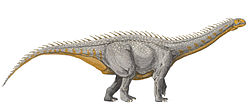| Datousaurus Temporal range: Middle Jurassic, | |
|---|---|
 | |
| Reconstructed skeleton | |
| Scientific classification | |
| Kingdom: | Animalia |
| Phylum: | Chordata |
| Class: | Reptilia |
| Clade: | Dinosauria |
| Clade: | Saurischia |
| Clade: | † Sauropodomorpha |
| Clade: | † Sauropoda |
| Family: | † Mamenchisauridae |
| Genus: | † Datousaurus Dong & Tang, 1984 |
| Species: | †D. bashanensis |
| Binomial name | |
| †Datousaurus bashanensis Dong & Tang, 1984 | |
Datousaurus (meaning "chieftain lizard" or "big-head lizard"; originally named using the Malay datu , after its Chinese nickname qiulong - literally "chieftain dragon" - but also a pun on its big head; da tou means "big head" in Chinese) [1] is a sauropod dinosaur from the Middle Jurassic Lower Shaximiao Formation in Sichuan province, China. It shared the local Middle Jurassic landscape with other sauropods such as Shunosaurus , Omeisaurus , and Protognathosaurus , the neornithischian Xiaosaurus , and the early stegosaur Huayangosaurus as well as the carnivorous Gasosaurus .













